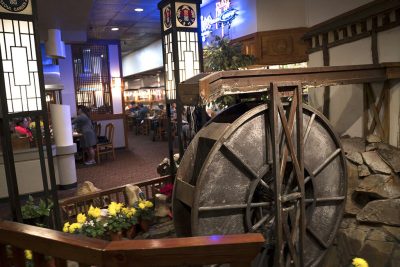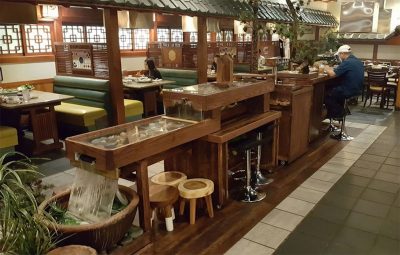
Long Point Road near Blalock Road is bustling, scrappy and effervescent with new businesses jammed into storefronts, kiosks and strip centers. Stately, though, it is not — unless you push open the heavy doors of two older businesses, Seoul Garden restaurant and its across-the-street neighbor, Korea Garden restaurant.
For close to three decades, serving classic cuisine refined over millennia, the two businesses have patiently – and confidently – served authentic Korean cuisine in the heart of the Houston region’s Korean-American community and business world.
And then, unexpectedly, about 10 years ago, both restaurants boomed.
To fully understand why, I needed to duck out of a noisy, blindingly bright day and into the peaceful, shadowy interiors of the two Long Point Korean restaurants.

Seoul Garden
At Seoul Garden, the foyer is designed to look like a Korean country garden. Outside was a baking blacktop, a nightclub and a man with a black eye. Inside: a meandering garden pool, a weathered wooden water wheel, shiny plants with dark leaves.
Then, a very few minutes later, carefully placed at our table: a dozen tiny dishes of banchan, or vegetable dishes — most of which I’d never tasted and each of which won me over at once. There were refreshing slices of chili-garlic seasoned cucumber, folded leaves of vinegary Napa cabbage kimchi, hunks of spicy marinated tofu and roasted cubed potatoes.
My two teenagers were won over, too. My daughter silently dug into a hot metal plate of bulgogi, served with crunchy romaine salad, authoritatively dressed with vinegar, chili and sesame oil. She said nothing until both were completely gone. (Dining parties at Seoul Garden can also cook their barbecue themselves at tabletop grills).
My son ordered doenjang jjigae, an iconic Korean stew flavored with fermented soy bean paste. Shrimp, mussels in the shell, vegetables and tofu chunks jostled at the surface like partiers in a hot tub. When I glanced up from my banchan, there was nothing left of the jjigae but a lone pink shrimp. But it was delectable, infused with a complex, earthy flavor I couldn’t place.
Our server, a woman about my age, watched intently.
“Did you like it?” she finally asked, peering at the empty bowl.
“We loved it,” we said at the same time.
“It wasn’t too strong?”
“No, no – it was perfect,” I answered.
“Sometimes new people don’t like it,” she said, visibly relaxing. Then she looked pleased.
“It’s flavored with fermented soy bean paste,” she said. “They keep the beans in a jar for a year. One whole year.”
Jjigae, New York Times food write Eric Kim explained in a recent article, is one of the dishes Koreans love most – and take the most pride in cooking well. For bean paste jjigae, beans and fermentation processes creates different, signature flavors. Every cook, he writes, does jjigae differently, Kim writes.
“You could have dinner at five Korean families’ homes, for instance, and the doenjang jjigae would taste different at each of them. Still, there are certain ingredients that come up time and time again (they also explain why Korean food tastes the way it does: savory, balanced, full of heart).”
The traditional presentation of a Korean meal reinforces the sense of balance and heart. A typical meal starts with banchan arriving, unrequested, before the entrée. They’re part of the nutritional – and aesthetic – balance of a Korean meal. Nibbling through each, I marveled at the care it must take for a Korean home cook to serve this kaleidoscope of vegetables night after night, and wash the tiny dishes afterward.

Korea Garden
I had the same feeling of being nurtured a few days later at Korea Garden, where chunky, tiled eaves overhang the booths and a traditional wooden gate swings open on the room with tabletop grills. Again, a cavalcade of banchan appeared, even though I was eating at the bar — crowded with condiments, napkin dispensers and a plastic vat with gingseng root in a clear liquid.
This time there was cabbage kimchi in slaw-like shreds, bean sprout kimchi, crunchy and blushing with gochujang paste, and two different kinds of seaweed – one black-green and drapey, the other glowing emerald green with tiny freckles of sesame seeds. My favorite dish was something I couldn’t identify: firm strips of something as chewy and savory as steak, blanketed in a sauce of sweet but fiery gochujang diluted with soy sauce.
“Fish cake,” Ok Yi, the owner, told me. “We buy it from Korea. Want some more? It’s free. What would you like?”
It was a distinctively personal, cosseting flourish I’d never seen at a restaurant – but is typical for Korea. A minute later, Yi had replenished my dish of green seaweed and set down an additional bowl of savory potatoes.
“I brought you something new,” she said.
I might have been a rewarding audience, singlehandedly emptying nine banchan bowls as well as a full serving of jjigae. But there is a reason Korean Americans, too, so often describe their cuisine as comfort food. Evolved in a climate with grueling winters, traditionally served in houses built for extended clans, Korean food and the experience of sharing it are designed to make diners feel warm and doted-on.
It all made me want to venture to some of the newer less established Korean restaurants that have now appeared on Long Point: the tiny crispy fried chicken shop, the “rice cake” bakery, a pocket noodle shop, all with clear signage for non-Asians.
After 30 years dominated by the big restaurants, I wondered, why has Long Point sprouted so many new ones?
“K-drama,” suggested Christy Kim, my server at Korea Garden.
Born and raised in South Korea, she has worked at the restaurant for 10 years and seen its popularity soar.
“They come in and want dishes they saw on a Korean show, especially Squid Game,” the popular, and sensational streaming video series, she said. “Although I’ve never seen it – too brutal for me.”
But even before Squid Game, her boss Yi said, new customers were inspired by K-Pop bands, herculean Korean skincare tutorials, and, perhaps Korea’s first international smash cultural export – the 2012 musical hit Gangnam Style.
“That’s when people really started coming in,” she recalled.
Non-Korean people, that is. For Korean-Americans, the reasons for pushing open the big doors of Long Point’s Korean food bastions are obvious. Both places, they know, take Korean cuisine and its traditions seriously.
“This jar,” Yi said, tapping the vat of ginseng sitting on the bar, “is something people usually have at home. The ginseng has been soaking in a low-alcohol Korean spirit called soju for 10 years . I’ve only changed it twice in all that time.”
Bartenders usually use a bit to flavor cocktails, she said.
Watching us from a nearby table littered with empty plates, an elderly man asked Yi a question in Korean.
“He wants to try some,” she said. Smiling indulgently, she ladled out a plastic cupful and brought it over to him. Then she stood by the table approvingly as he drained the glass.
Seoul Garden
9446 Long Point Rd., Houston 77055
713.935.9696
http://www.
Open 10:30 a.m. – 10 p.m.
Korea Garden
9501 Long Point Rd, Houston 77055
713.468.2800
https://koreagardenhouston.
Open 11 a.m. – 10 p.m.
— By Claudia Kolker





